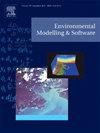Distilling the Pareto optimal front into actionable insights
IF 4.8
2区 环境科学与生态学
Q1 COMPUTER SCIENCE, INTERDISCIPLINARY APPLICATIONS
引用次数: 0
Abstract
Multi-objective optimization (MOO) is becoming increasingly important in environmental decision making, but interpreting highly-dimensional Pareto optimal data often constitutes a cognitive overload for both scientists and stakeholders. To address this challenge, we present PyretoClustR, a modular framework for post-processing Pareto optimal solutions. This tool aims to increase accessibility and applicability of MOO results by introducing a low-lift, iterative method to reduce the Pareto front. PyretoClustR is adaptable to various environmental datasets and decision-making scenarios, automatically selecting effective parameters for principal component analysis, clustering, and outlier handling. It produces digestible visualizations of the pruned dataset for decision-makers. We demonstrate its effectiveness using MOO results from a multifunctional landscape, highlighting trade-offs between agricultural productivity, biodiversity, water quality, and ecological flow. PyretoClustR successfully reduced the Pareto front (2419 points) to 18 representative solutions with a silhouette score of 0.33 based on decision space variables, facilitating understanding of MOO for informed decision making.

将帕累托最优前沿提炼成可操作的见解
多目标优化(MOO)在环境决策中变得越来越重要,但对于科学家和利益相关者来说,解释高维帕累托最优数据往往构成认知过载。为了应对这一挑战,我们提出了PyretoClustR,这是一个用于后处理帕累托最优解的模块化框架。该工具旨在通过引入低升程迭代方法来减少Pareto锋,从而提高MOO结果的可访问性和适用性。PyretoClustR适用于各种环境数据集和决策场景,自动选择有效参数进行主成分分析,聚类和异常值处理。它为决策者生成易于理解的修剪数据集的可视化。我们利用多功能景观的MOO结果证明了其有效性,突出了农业生产力、生物多样性、水质和生态流量之间的权衡。PyretoClustR基于决策空间变量成功地将Pareto前沿(2419个点)简化为18个具有代表性的解决方案,剪影得分为0.33,有助于理解MOO以进行明智的决策。
本文章由计算机程序翻译,如有差异,请以英文原文为准。
求助全文
约1分钟内获得全文
求助全文
来源期刊

Environmental Modelling & Software
工程技术-工程:环境
CiteScore
9.30
自引率
8.20%
发文量
241
审稿时长
60 days
期刊介绍:
Environmental Modelling & Software publishes contributions, in the form of research articles, reviews and short communications, on recent advances in environmental modelling and/or software. The aim is to improve our capacity to represent, understand, predict or manage the behaviour of environmental systems at all practical scales, and to communicate those improvements to a wide scientific and professional audience.
 求助内容:
求助内容: 应助结果提醒方式:
应助结果提醒方式:


